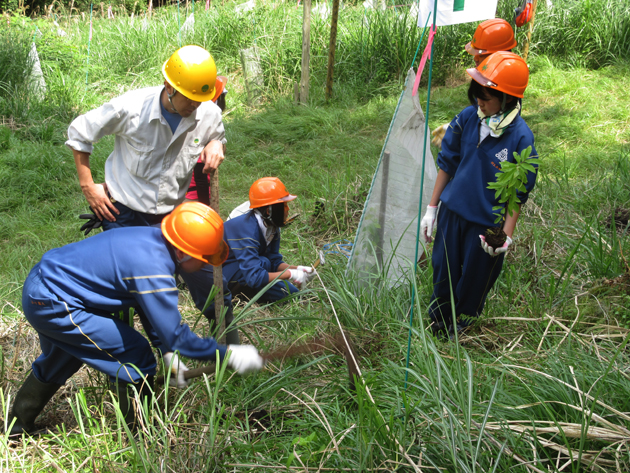conserve
Integrated Studies, “Ubusuna Time”
Ofunato Massaki Junior High School
Since 2002, Massaki Junior High School has set aside time to learn about their region, which they call “Ubusuna Time.” In the first and second year, they plant, harvest, and sell seaweed, and in the third year the students plant and cut down trees to learn about forest maintenance.
The Ofunato Massaki Junior High School in Iwate Prefecture has adopted an integrated study program they named, “Ubusuna Time.” 2016 marked the 15th year of this program, and it has become one of the key pillars of Massaki Junior High School’s curriculum. “Ubusuna” means something born from the land, and Massaki village is known as the birthplace of “Sanriku seaweed farming.” By recognizing the values of the unique regional characteristics nurtured over the years by their forefathers, they hope children will discover their own way of life.
The classes are taught by local seaweed farmers and many others. First year at the junior high school, the students sow seeds, take part in early harvests and regular harvests, then boil and cure the harvested seaweed in salt. The second year, the students split up into a few groups and visit fishermen to learn how to separate the leaf from the stem. Then, back at school, the students separate the harvested seaweed from the stem and package the seaweed to sell as “Massaki Junior High Fureai Wakame.” Once the products are ready, guest lecturers from companies teach the students about customer service before the student begin selling their seaweed in Morioka City. Over the 3 years that they spend at the junior high school, the students systematically learn and experience from cultivating seaweed.
The theme for third year students is “protecting the ocean,” and the students learn about forest maintenance and how that helps protect the ocean and its bounty. In 2003, the school signed an agreement with the Minamisanriku Central District Forest Office to promote environmental education of forests. The students learn about the roles the forest plays from the District Forest Office staff and help maintenance an area of the government-owned forest by planting trees, clearing underbrush, tree thinning, etc. From these activities, the students learn about the importance of forests and how the natural environment, from the forest to the ocean, is all connected.
In March 2011, the seaweed cultivation site and ocean field study site suffered catastrophic damage from the tsunami caused by the Great East Japan Earthquake. But as a result of the efforts of the Minamihama Seaweed Cultivation Association and the fisheries cooperative as well as the people of the region, the classes were back up and running by November of the same year. This fiscal year, the students will put on a performance about Mr. Tozo Komatsu, the father of the seaweed farming technology. The school hopes to make students aware of the efforts that went into developing the technology and how the region has recovered from past disasters, so that the students, who experienced the Great East Japan Earthquake, can realize the role they can play in the restoration of the region.
更新日:2016.11.18 ※記事の内容は投稿当時のものです











